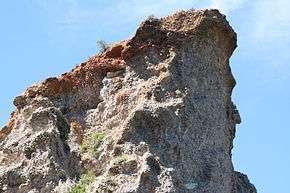Alluvium
Alluvium (from the Latin alluvius, from alluere, "to wash against") is loose, unconsolidated (not cemented together into a solid rock) soil or sediment that has been eroded, reshaped by water in some form, and redeposited in a non-marine setting.[1][2] Alluvium is typically made up of a variety of materials, including fine particles of silt and clay and larger particles of sand and gravel. When this loose alluvial material is deposited or cemented into a lithological unit, or lithified, it is called an alluvial deposit.[3]



Definitions
The term "alluvium" is not typically used in situations where the formation of the sediment can clearly be attributed to another geologic process that is well described. This includes (but is not limited to): lake sediments (lacustrine), river sediments (fluvial), or glacially-derived sediments (glacial till). Sediments that are formed or deposited in a perennial stream or river are typically not referred to as alluvial.[3]
Age
Most alluvium is geologically Quaternary in age and is often referred to as "cover" because these sediments obscure the underlying bedrock. Most sedimentary material that fills a basin ("basin fill") that is not lithified is typically lumped together as "alluvial".[3] Alluvium of Pliocene age occurs, for example, in parts of Idaho.[4] Alluvium of late Miocene age occurs, for example, in the valley of the San Joaquin River, California.[5]
See also
References
- Glossary of Geological Terms. Geotech.org. Retrieved on 2012-02-12.
- Geology Dictionary – Alluvial, Aquiclude, Arkose. Geology.Com. Retrieved on 2012-02-12.
- Chisholm, 1911
- Ames, Dan (1998), "Formation of the Soils" (PDF), Soil Survey of Jerome County and Part of Twin Falls County, Idaho, Natural Resources Conservation Service, USA, p. 238
- Huber, N. King (1981). Amount and Timing of Late Cenozoic Uplift and Tilt of the Central Sierra Nevada, California—Evidence from the Upper San Joaquin River Basin (USGS Professional Paper 1197) (PDF). Washington D.C.: USGS. p. 13.
External links
| Wikimedia Commons has media related to Alluvium. |
- Chisholm, Hugh, ed. (1911). . Encyclopædia Britannica (11th ed.). Cambridge University Press.